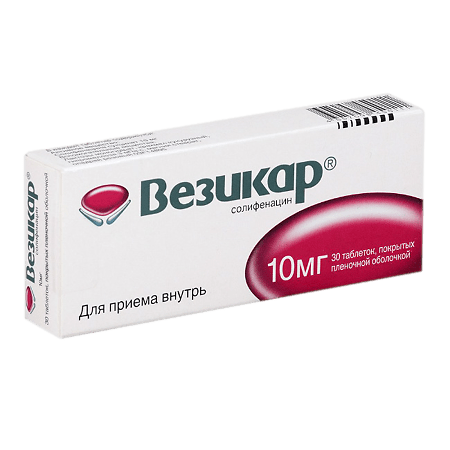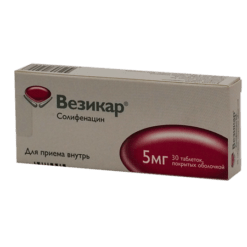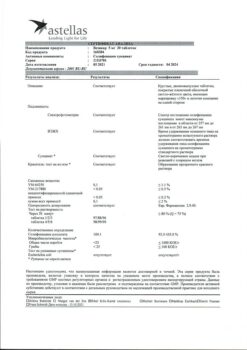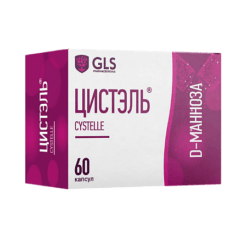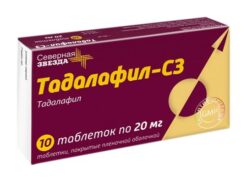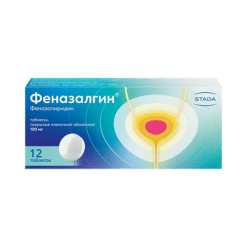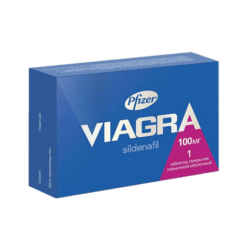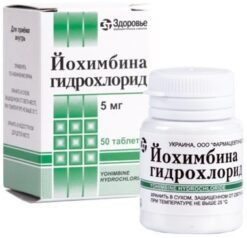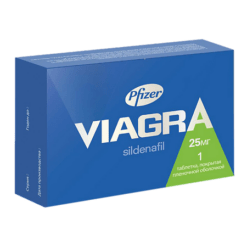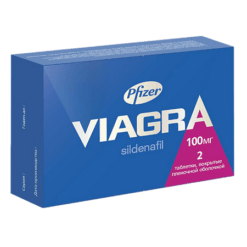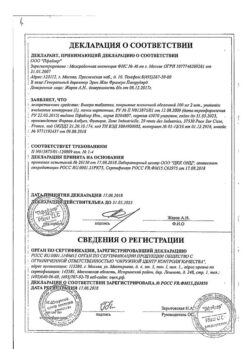No products in the cart.
Vesicar, 10 mg 30 pcs.
€31.94 €26.61
Description
Mechanism of action
Solifenacin is a specific competitive muscarinic receptor antagonist. The bladder is innervated by parasympathetic cholinergic nerves. Acetylcholine acts on muscarinic receptors (mainly M3) and causes detrusor contraction.
Pharmacological studies conducted in vitro and in vivo have shown that solifenacin is a specific competitive inhibitor of muscarinic M3 subtype receptors. Solifenacin was also found to have low or no affinity to various other receptors and ion channels.
Pharmacodynamics
The efficacy of Vesicar at doses of 5 mg and 10 mg, studied in several double-blind, randomized, controlled clinical trials in men and women with overactive bladder syndrome, was observed during the first week of treatment and stabilized over the following 12 weeks of treatment.
A long-term open-label clinical trial showed that efficacy was maintained for at least 12 months. After 12 weeks of use, approximately 50% of patients who suffered from urinary incontinence prior to treatment stopped experiencing urinary incontinence, and 35% of patients achieved a reduction in urinary frequency of less than 8 per day.
Treatment of symptoms of overactive bladder (UBG) resulted in meaningful improvements in quality of life measures. The maximum effect of Vesicar can be detected after 4 weeks.
Pharmacokinetics
General characteristics
Absorption: Maximum plasma concentration (Cmax) is reached after 3-8 hours. Time to reach maximum concentration (tmax) is independent of the dose. Cmax and area under the curve (AUC) of concentration versus time increase in proportion to increasing dose from 5 to 40 mg. Absolute bioavailability is 90%. Food intake has no effect on the Cmax and AUC of solifenacin.
Distribution: The volume of distribution of solifenacin after intravenous administration is approximately 600 l. Solifenacin is largely (approximately 98%) bound to plasma proteins, primarily α1-acid glycoprotein.
Metabolism: Solifenacin is actively metabolized by the liver, primarily by the CYP3A4 isoenzyme. However, there are alternative metabolic pathways through which solifenacin may be metabolized.
Systemic clearance of solifenacin is approximately 9.5 l/hour and terminal elimination half-life is 45-68 hours. After oral administration the following metabolites were identified in plasma in addition to solifenacin: one pharmacologically active (4R-hydroxysolifenacin) and three inactive (N-glucuronide, N-oxide and 4R-hydroxy-N-oxide of solifenacin).
Excretion: After a single administration of 10 mg of 14C-labeled solifenacin after 26 days, approximately 70% radioactivity was detected in the urine and 23% in the feces.
In the urine, approximately 11% of radioactivity was found as unchanged active substance, approximately 18% as N-oxide metabolite, 9% as 4R-hydroxy-N-oxide metabolite, and 8% as 4R-hydroxy metabolite (active metabolite). The pharmacokinetics of solifenacin is linear in the therapeutic dose range.
Features of pharmacokinetics in certain categories of patients
Age:
There is no need to adjust the dose according to the age of patients. Studies have shown that exposure to solifenacin (5 and 10 mg), expressed as AUC, was similar in healthy older individuals (65 to 80 years) and in healthy younger individuals (<55 years).
The mean absorption rate, expressed as tmax, was slightly lower and the final elimination half-life was approximately 20% longer in older individuals. These minor differences are not clinically significant.
Solifenacin pharmacokinetics were not determined in children and adolescents.
Gender: Solifenacin pharmacokinetics are independent of patient gender.
Race: Race has no effect on the pharmacokinetics of solifenacin.
Renal failure: The AUC and Cmax of solifenacin in patients with mild to moderate renal failure are not significantly different from those in healthy volunteers. In patients with severe renal insufficiency (creatinine clearance <30 ml/min) solifenacin exposure is significantly higher – Cmax increase is about 30%, AUC – more than 100% and t1/2 – more than 60%. There is a statistically significant relationship between creatinine clearance and solifenacin clearance. Pharmacokinetics in patients undergoing hemodialysis has not been studied.
Hepatic failure: In patients with moderate hepatic failure (stage B according to Child-Pugh classification) Cmax value is not changed, AUC-increases by 60%, t1/2 is doubled. Pharmacokinetics in patients with severe hepatic insufficiency was not determined.
Indications
Indications
Treatment of urgent (imperative) urinary incontinence, frequent urination and urgent (imperative) urge to urinate characteristic of patients with overactive bladder syndrome.
Active ingredient
Active ingredient
Composition
Composition
Each 10 mg tablet contains:
tablet core composition: solifenacin succinate 10.0 mg, lactose monohydrate 102.5 mg, corn starch 30.0 mg, hypromellose 3 mPas – 6.0 mg, magnesium stearate – 1.5 mg, purified water* – 54.0 mg;
tablet film coating composition: Opadray Pink 03F14895 – 4.0 mg (hypromellose 6 mPa c – 62.0%, talc – 18.59%, macrogol 8000 – 11.63%, titanium dioxide – 7.75%, iron oxide red – 0.03%), purified water* – 36.0 mg.
* – water is removed during production.
How to take, the dosage
How to take, the dosage
Adults, including the elderly
5 mg once daily orally, whole with liquids, regardless of the time of the meal. If necessary, the dose may be increased to 10 mg once daily.
Children
The safety and effectiveness of Vezicar in children has not been studied. Therefore, Vezicar should not be used in children.
Patients with renal impairment
No dose adjustment is required in patients with mild to moderate renal impairment (creatinine clearance > 30 ml/min). In patients with severe renal impairment (creatinine clearance < 30 ml/min) solifenacin should be administered with caution and should not be administered more than 5 mg daily.
Patients with hepatic impairment
No dose adjustment is required in patients with mild hepatic impairment. In patients with moderate hepatic impairment (Child-Pugh stage B), solifenacin should be administered with caution and should not be prescribed more than 5 mg daily.
Patients receiving strong CYP3A4 isoenzyme inhibitors
The maximum dose of Vesicar should be limited to 5 mg when taken together with ketoconazole or a therapeutic dose of another CYP3A4 isoenzyme inhibitor (ritonavir, nelfinavir, itraconazole).
Interaction
Interaction
Pharmacological interaction
Continuous treatment with drugs with anticholinergic properties may lead to more pronounced therapeutic and adverse effects. After stopping solifenacin, you should take a break of about a week before starting treatment with another anticholinergic drug.
Therapeutic effects may be reduced if cholinergic receptor agonists are taken concomitantly. Solifenacin may decrease the effect of drugs that stimulate gastrointestinal motility, such as metoclopramide and cisapride.
Pharmacokinetic interaction
Invitro studies have shown that at therapeutic concentrations, solifenacin does not inhibit the CYP1A1/2, 2C9, 2C19, 2D6 or ZA4 isoenzymes isolated from human liver microsomes. Therefore, it is unlikely that solifenacin will alter the clearance of drugs metabolized by these CYP enzymes.
The effects of other drugs on the pharmacokinetics of solifenacin
Solifenacin is metabolized by the CYP3A4 isoenzyme. Concomitant administration of ketoconazole (200 mg/day), a strong CYP3A4 isoenzyme inhibitor, caused a twofold increase in the AUC time-dependent concentration of solifenacin, and a threefold increase in the dose of 400 mg/day.
Therefore, the maximum dose of Vezicar should not exceed 5 mg if the patient simultaneously takes ketoconazole or therapeutic doses of other strong CYP3A4 isoenzyme inhibitors (such as ritonavir, nelfinavir, itraconazole). Concomitant treatment with solifenacin and strong CYP3A4 isoenzyme inhibitor is contraindicated in patients with severe renal impairment or with moderate hepatic impairment. Enzyme induction phenomena on the pharmacokinetics of solifenacin and its metabolites have not been studied, as well as the effect of high-affinity CYP3A4 isoenzyme substrates on the action of solifenacin.
As solifenacin is metabolized by CYP3A4 isoenzyme, pharmacokinetic interactions are possible with other CYP3A4 isoenzyme substrates with higher affinity (verapamil, diltiazem) and with CYP3A4 isoenzyme inducers (rifampicin, phenytoin, carbamazepine).
The effect of solifenacin on the pharmacokinetics of other medicinal products
Oral contraceptives: No pharmacokinetic interaction of solifenacin and combined oral contraceptives (ethinylestradiol/levonorgestrel) was found.
Warfarin: Administration of Vesicar did not cause changes in the pharmacokinetics of R-warfarin or S-warfarin or their effect on prothrombin time.
Digoxin: Administration of Vesicar had no effect on the pharmacokinetics of digoxin.
Special Instructions
Special Instructions
Before starting treatment with Vesicar, it should be determined whether there are no other causes of frequent urination (heart failure or kidney disease). If a urinary tract infection is detected, appropriate antibacterial treatment should be started. Vesicar should be prescribed with caution in patients:
– with clinically significant bladder outlet obstruction leading to risk of urinary retention;
– with gastrointestinal obstructive disease;
– with risk of decreased gastrointestinal motility;
– with severe renal (creatinine clearance – simultaneously taking a strong CYP3A4 inhibitor such as ketoconazole;
– with hernia of the diaphragm, gastroesophageal reflux and patients simultaneously taking medications (such as bisphosphonates) that may cause or aggravate esophagitis;
– with autonomic neuropathy.
Patients with rare hereditary galactose intolerance disorders, lactase deficiency lopari (Sami), glucose-galactose malabsorption should not take the drug.
Impact on driving and operating machinery
Solifenacin, like other anticholinergic drugs, may cause blurred vision and (rarely) drowsiness and fatigue, which may impair the ability to drive and operate machinery.
Contraindications
Contraindications
With caution
Before starting treatment with Vesicar, it should be determined whether there are no other causes of urinary disorders (heart failure or kidney disease). If a urinary tract infection is detected, appropriate antibacterial treatment should be started. Vesicar should be prescribed with caution in patients:
Side effects
Side effects
Most common – dry mouth mucosa (11% – when taken in a dose of 5 mg daily, 22% – 10 mg daily).
Frequent (more than 1/100 and less than 1/10), infrequent (more than 1/1000 and less than 1/100), rare (more than 1/10000 and less than 1/1000).
Digestive system disorders: frequent – constipation, nausea, dyspepsia, abdominal pain; infrequent – gastroesophageal reflux disease, dry pharyngeal mucosa; rare – intestinal obstruction, coprostasis.
Nervous system disorders: infrequent – somnolence, impaired taste.
Sensory system disorders: frequent – blurred vision (accommodation disorder); infrequent – dry eyes.
Respiratory system: infrequent – dry nasal mucosa.
Skin disorders: infrequent – dry skin.
Perior urinary system disorders: infrequent – difficulty in urination; rare – urinary retention.
Others: infrequent – urinary tract infections, fatigue, peripheral edema.
Overdose
Overdose
The highest dose of solifenacin used by volunteers was 100 mg as a single dose. The most commonly reported side effects at this dose were headache (mild), dry mouth (moderate), dizziness (moderate), drowsiness (mild), and blurred vision (moderate). No cases of acute overdose have been reported. In cases of overdose, activated charcoal should be administered and gastric lavage should be performed, but vomiting should not be induced.
As in cases of overdose of other anticholinergic agents, symptoms should be treated as follows:
– for severe central anticholinergic effects (hallucinations, marked excitability) – physostigmine or carbachol;
– for seizures or marked excitability – benzodiazepines;
– In respiratory failure – artificial respiration;
– In tachycardia – beta-blockers;
– In urinary retention – catheterization;
– In mydriasis – inject pilocarpine into the eyes and/or place the patient in a dark room.
As with overdose of other anticholinergic drugs, special attention should be paid to patients with an established risk of QT interval prolongation (i.e., hypokalemia, bradycardia, and concurrent administration of QT interval prolongation drugs) and patients with cardiac disease (myocardial ischemia, arrhythmias, congestive heart failure).
Pregnancy use
Pregnancy use
There are no clinical data on women who have become pregnant while taking solifenacin. Animal studies have shown no direct adverse effects on fertility, embryo/fetal development, or childbirth.
Caution should be exercised when prescribing this drug to pregnant women only if the potential benefit to the mother exceeds the potential risk to the fetus.
There are no data on the excretion of solifenacin into the breast milk. In mice, solifenacin and/or its metabolites were excreted into breast milk and caused a dose-dependent developmental disorder in newborn mice. The use of Vezicar is not recommended during breastfeeding.
Similarities
Similarities
Additional information
| Manufacturer | Astellas Pharma Europe B.V., Netherlands |
|---|---|
| Medication form | pills |
| Brand | Astellas Pharma Europe B.V. |
Other forms…
Related products
Buy Vesicar, 10 mg 30 pcs. with delivery to USA, UK, Europe and over 120 other countries.

